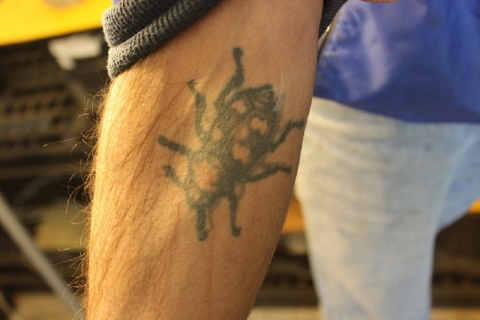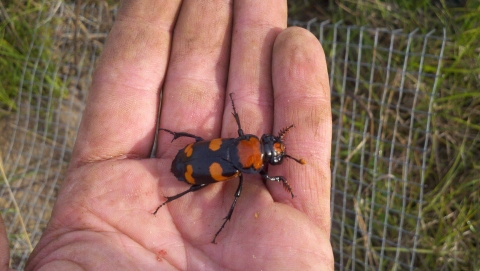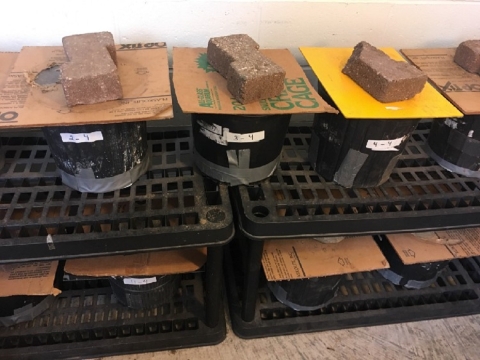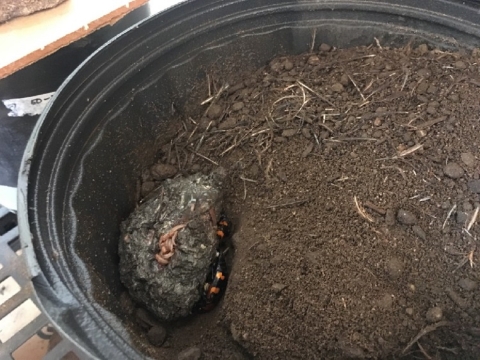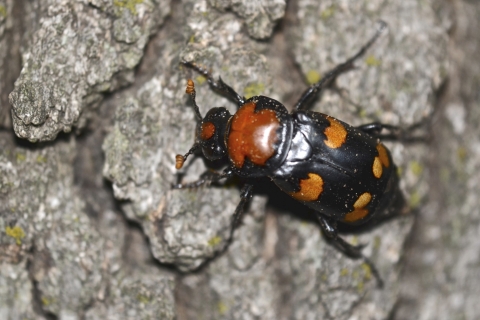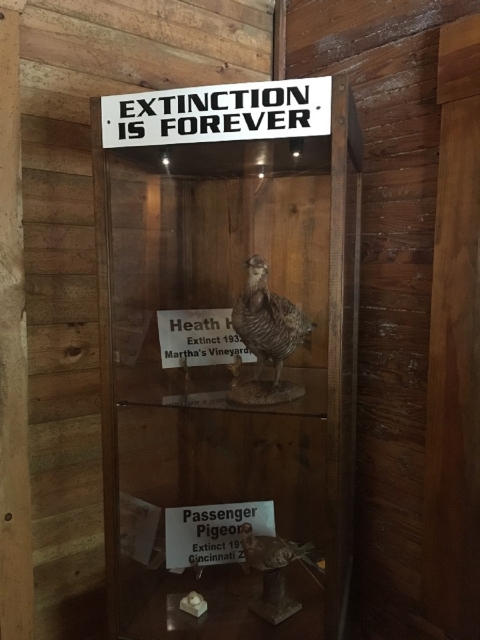In 1994, Lou Perrotti was asked to take on an urgent new assignment at work. It’s unlikely he imagined it would result in monthly handwritten notes from Jane Goodall and a larger-than-life beetle tattoo on his right forearm. It wouldn’t have mattered.
“When the Service approached us and asked if we’d like to be the facility that rears American burying beetle, we said: ‘Yes! This is amazing,’ ” said Perrotti, director of conservation programs at the Roger Williams Park Zoo in Providence, Rhode Island. Five years earlier, the American burying beetle had been placed on the federal endangered species list.
“We knew invertebrate conservation was going to be the future,” Perrotti said.
“These are the little things that run the planet.”
By the early 1980s, scientists were concerned about the prospects for American burying beetle, an invertebrate that does its part to keep the planet running by burying the carcasses of dead animals. Why does that matter? Burying dead stuff keeps populations of flies and ants in check, and speeds up the recycling of nutrients. Not to mention, it’s just an impressive feat. American burying beetles can bury something about 80 times their weight in less than 24 hours. Consider how long it would take you to dig a hole large enough to bury a small school bus. Without a shovel.
Once widely distributed across eastern North America, the beetles’ population plummeted in the 20th century. In 1983, experts completed the first coordinated global effort to collect data on the status of invertebrates, ranging from mollusks to spiders to insects, and published their findings in a book. It contained a blaring wake-up call for American burying beetle. The experts wrote that the trajectory of this species “must represent one of the most disastrous declines of an insect’s range ever to be recorded.” The U.S. Fish and Wildlife Service used this research to inform the decision to add American burying beetle to the endangered species list in 1989.
No single catastrophic event led to the beetle’s decline, but it’s easy to envision how it came about. In the mid-1900s, rapid changes in land use — urbanization, overgrazing, oil and gas development, industrial-scale agriculture — fragmented the eastern United States. Beetle populations were isolated from each other and from their prey, leading to localized extirpations that created gaps across the range. Picture lights in a building blinking out until it’s too dark to find your way from room to room. Darkness spread over the landscape of the American burying beetle, like a curtain drawing closed.
But some of the lights never went out. American burying beetle managed to persist in areas of the western edge of the range, and on Block Island, off the southern coast of Rhode Island.
As disastrous as the species’ decline was, the story of its recovery is equally remarkable. Jane Goodall dedicated an entire chapter of her 2009 book Hope for Animals and Their World to the American burying beetle, in a section called “Saved at the Eleventh Hour” — hence her regular correspondence with Perrotti.
Thanks to collaborative conservation efforts by the zoo, The Nature Conservancy, the Maria Mitchell Association, the Massachusetts Division of Fisheries and Wildlife, Rhode Island Department of Environmental Management, and the Service, the Block Island beetles have spawned hope for the future of their species. The impact of these efforts on the trajectory of this species, and the threats it still faces, are detailed in an updated species status assessment (SSA) report released by the Service.
Though challenges remain, the beetle is moving in the right direction: Thirty years after adding the American burying beetle to the endangered species list, the Service proposed in May 2019 to downlist the species from endangered to threatened.
A day in the life
“This is the Animal Care Department’s bay,” Perrotti said, as we entered a warehouse a short drive from the main campus of the Roger Williams Park Zoo. “And this used to be an office,” he said. Nowadays it would be difficult to get much work done in the small room he led me into — it was uncomfortably warm, and stuffy with the smell of decay. But the conditions are ideal for beetles.
There were low shelving units stacked against two of the walls, lined with black, plastic buckets, each capped with a square of cardboard secured in place by a brick. The buckets contained dirt, a female and a male American burying beetle, and a dead quail — supposedly. Stripped of feathers, missing heads, and covered with what looked like dirty plastic wrap, they bore no resemblance to stocky ground-nesting birds.
“If you notice, it has a smell, but not the smell of a week-old dead thing,” Perrotti said, lifting the cardboard cover from one of the buckets. “It’s completely preserved by the beetles’ secretions.”
To his delight, some of the buckets also contained larvae, which will feed for about a week on the carcass their parents have prepared for them, and then crawl into the soil to mature.
These larvae are the descendants of beetles captured on Block Island to seed the zoo’s captive-breeding program, which has made it possible to reintroduce the species to another site within its historic range: the island of Nantucket.
Since 1994, Perrotti has led a reintroduction program on the island off the south coast of Cape Cod in partnership with the Maria Mitchell Association; their team releases American burying beetles, provisioning them with dead quails to support larval production, and monitoring their productivity through trapping and tagging.
Perrotti provides the technical expertise, while the Maria Mitchell Association provides housing, lab space, and interns to do some of the grunt work — “Like wash the glass jars we use to catch the beetles, chop rotting chicken, and weigh and measure the quails,” explained Elisabeth Sorrows, the natural science museum manager for the Maria Mitchell Association, and a former intern.
The rotting chicken is used as bait for the beetle traps, and the quail is a sort of nest egg. “We dig a hole with enough space for the quail and the beetles, put the turf clod back on top, and cover it with screen to keep the crows out,” Sorrows said. About a week later, they go back to check for larvae. “That’s about when the male and female would be taking leave from caring for the young,” she said, noting that American burying beetle are unique in the insect world for their equal sharing of parental duties.
In addition to helping reestablish a new population, the reintroduction program has helped scientists investigate the limiting factors for this species.
In 2012, they decided to cut back on provisioning on Nantucket to see if the population could sustain itself. The numbers declined, so they resumed stocking quails. But they learned something important in the process.
“We consider the reintroduction a success given how many beetles we now have on Nantucket, but we now know that management will be necessary until we figure out what is missing in the ecosystem,” said Cynthia Corsair, a fish and wildlife biologist for the Service.
Nantucket gives them a homologous system to compare with Block Island, where all of the key ingredients to support the beetle seem to be in place already. “We’ve always wanted to know: Why was it never extirpated from Block Island? What was it that kept it going there?” Perrotti said.
There’s a good chance the answer is buried underground.
You’ve got to hide your dove away
Although American burying beetle are habitat generalists, they are carrion specialists. “They can only use a carrion item that is between 80 and 180 grams,” Perrotti explained. “It has to be something about the size of a dove or a pigeon.” Or a young ring-necked pheasant, which are more abundant on Block Island than on Nantucket.
Narrowing in on the beetles’ carrion preferences will be key to ensuring its future, and scientists are on the verge of cracking the code. Scott Comings, associate director of the Rhode Island chapter of The Nature Conservancy, which manages a 600-acre parcel of land for American burying beetle on Block Island, explained that a graduate student from Purdue University is working on reconstructing the food web of the Block Island beetles.
Using genetic information taken from microscopic pieces of their wing covers, the student Brandon Quinby will be able to determine what the beetles are feeding on during all life stages, but most importantly, what they fed on as larvae; in other words, what their parents used as carrion to raise their brood.
“That will tell us what they use to reproduce, which will help us find the best carrion opportunities for them,” Comings said. That information will be invaluable for keeping existing populations of American burying beetle stable, and possibly, for establishing new ones.
It may also provide a clue to what happened in the beetles’ past. Passenger pigeon, Carolina parakeet, and heath hen are all birds that may have been in the carrion sweet spot for American burying beetle. They are also all extinct.
But the beetle has something those birds didn’t. Dedicated and coordinated partners.
“Conservation on behalf of the burying beetle has been happening for a long time,” said Comings, noting that he was considered the “new guy” when he became involved in the effort on Block Island more than two decades ago.
“But we are still pushing the knowledge boundaries, using new and better technology to get a handle on this species,” he said. “It’s a real success story for how partnerships can achieve great things because we all bring different strengths.”


